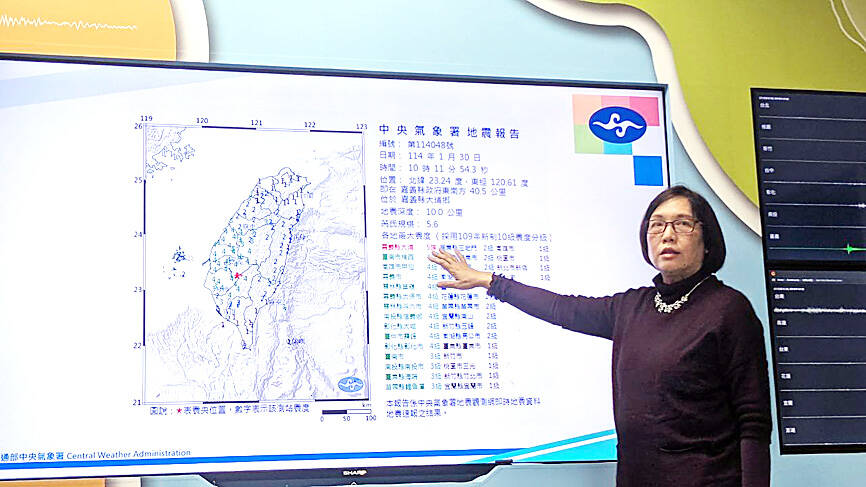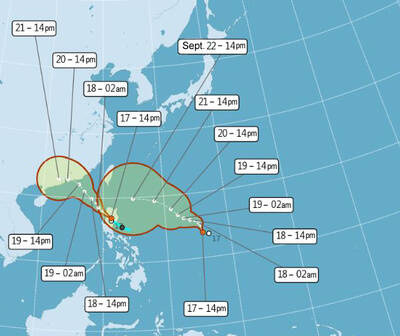More seismic activity is expected in the coming week or two, the Central Weather Administration (CWA) said after a magnitude 5.6 earthquake on the Richter scale jolted Chiayi County yesterday morning.
The hypocenter of the quake, which occurred at 10:11am, was in Dapu Township (大埔) at a depth of 10km, CWA data showed.
The quake’s intensity, which measures the perceptible effects of a seismic event, was highest in Chiayi County, where it registered 5 on Taiwan’s seven-tier scale.

Photo: CNA
That was followed shortly afterward by at least a dozen smaller quakes in Dapu. No casualties were reported.
The agency’s Seismological Center said the series of earthquakes were aftershocks of the magnitude 6.4 earthquake that struck Dapu on Tuesday last week.
“Although the frequency of aftershocks from the Jan. 21 quake has gradually decreased recently, there is still a possibility of larger-scale aftershocks in the next one to two weeks,” center head Ho Mei-yi (何美儀) said.

Photo courtesy of the Tainan Fire Bureau via CNA
Taiwan is at the junction of the Eurasian Plate and the Philippine Sea Plate. Interactions between the two plates causes frequent seismic activity in the eastern half of Taiwan proper, she said.
“As tectonic stress from that activity moves toward the western half of the island and gradually accumulates there, it begins to cause earthquakes there as well,” she said, adding that last week’s earthquake was one such example.
There are numerous fault lines in the area around Chiayi and Tainan, and the interaction of the nearby tectonic plates makes the area an earthquake hotspot, she said.
Aftershocks of last week’s earthquake that reached magnitude 5.5 or above occurred on Saturday, Sunday and yesterday, she said.
“The aftershocks that have occurred to date have been distributed over a wide area, and have not followed any clear trend. This is due to the complex interlacing of the fault lines and the distribution of the seismic energy,” she said.
Yesterday alone, 134 aftershocks were recorded after the quake, she said, adding that 38 were significantly felt and 96 were small regional earthquakes.
As seismologists are unable to predict when the frequency of earthquakes in the area would return to normal, and as huge aftershocks are still expected in the coming one to two weeks, the public should remain vigilant, she said.
Some trains on the Taiwan High Speed Rail network were delayed by up to 70 minutes after yesterday’s quake, the operator said, adding that it had deployed an emergency response team and carried out operational checks.
All speed limits were lifted at 12:45pm after it was confirmed there were no security risks.
Taiwan Railway Corp (臺鐵) reduced train speeds to between 30kph and 60kph as a safety measure, and resumed normal operations after tests showed no abnormalities.
No injuries were reported in the Southern Taiwan Science Park (南部科學園區), where some operations at Taiwan Semiconductor Manufacturing Co (TSMC, 台積電) and United Microelectronics Corp (UMC, 聯電) were temporarily halted as a precaution.
The Zengwen Reservoir’s (曾文水庫) management office said it had received reports of rocks falling from a nearby slope, but no damage or injuries were reported.
The Southern Region Water Resources Branch advised the public to avoid mountainous areas in the county in the wake of the aftershocks.
The Dapu Township Office reported that the bronze statue of Chiang Kai-shek (蔣中正) installed in the reservoir collapsed and sank into the water.
The statue had previously been damaged due to years of exposure to wind, rain and the sun, and was restored by the township two years ago, Dapu Township Mayor Wu Min-hsun (吳明勳) said.
“However, the recent earthquakes damaged it again, and then it suddenly collapsed,” he said, adding that whether to salvage it would need to be discussed, as the reservoir is currently at capacity.
Additional reporting by Liu Wan-chun, Tsai Tsung-hsun, CNA and AP

Taiwan is projected to lose a working-age population of about 6.67 million people in two waves of retirement in the coming years, as the nation confronts accelerating demographic decline and a shortage of younger workers to take their place, the Ministry of the Interior said. Taiwan experienced its largest baby boom between 1958 and 1966, when the population grew by 3.78 million, followed by a second surge of 2.89 million between 1976 and 1982, ministry data showed. In 2023, the first of those baby boom generations — those born in the late 1950s and early 1960s — began to enter retirement, triggering

One of two tropical depressions that formed off Taiwan yesterday morning could turn into a moderate typhoon by the weekend, the Central Weather Administration (CWA) said yesterday. Tropical Depression No. 21 formed at 8am about 1,850km off the southeast coast, CWA forecaster Lee Meng-hsuan (李孟軒) said. The weather system is expected to move northwest as it builds momentum, possibly intensifying this weekend into a typhoon, which would be called Mitag, Lee said. The radius of the storm is expected to reach almost 200km, she said. It is forecast to approach the southeast of Taiwan on Monday next week and pass through the Bashi Channel

NO CHANGE: The TRA makes clear that the US does not consider the status of Taiwan to have been determined by WWII-era documents, a former AIT deputy director said The American Institute in Taiwan’s (AIT) comments that World War-II era documents do not determine Taiwan’s political status accurately conveyed the US’ stance, the US Department of State said. An AIT spokesperson on Saturday said that a Chinese official mischaracterized World War II-era documents as stating that Taiwan was ceded to the China. The remarks from the US’ de facto embassy in Taiwan drew criticism from the Ma Ying-jeou Foundation, whose director said the comments put Taiwan in danger. The Chinese-language United Daily News yesterday reported that a US State Department spokesperson confirmed the AIT’s position. They added that the US would continue to

The number of Chinese spouses applying for dependent residency as well as long-term residency in Taiwan has decreased, the Mainland Affairs Council said yesterday, adding that the reduction of Chinese spouses staying or living in Taiwan is only one facet reflecting the general decrease in the number of people willing to get married in Taiwan. The number of Chinese spouses applying for dependent residency last year was 7,123, down by 2,931, or 29.15 percent, from the previous year. The same census showed that the number of Chinese spouses applying for long-term residency and receiving approval last year stood at 2,973, down 1,520,